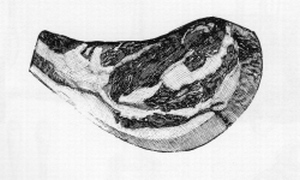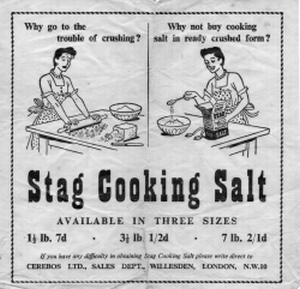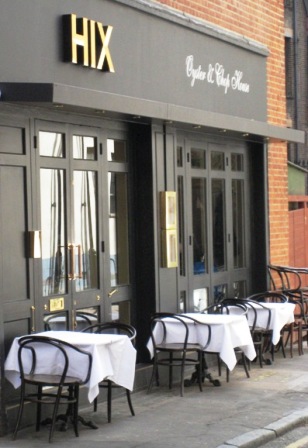A Case Study in Branding: the Conglomeration of Mark Hix (with Restaurant Review of Hix Oyster & Chop House)
I. A Case Study in Branding: The Conglomeration of Mark Hix.
Mark Hix stands in an enviable position atop the British culinary pyramid. He has created a recognizable, successful brand that encompasses television, publications, revered restaurants, a food festival and even some original and enticing merchandise. Lots of chefs on both sides of the Atlantic have attempted the same thing; so far, Hix has executed his business plan particularly well.

The television productions, involving travel throughout Britain to catalog and assess regional and seasonal foods, are beautifully produced and deservedly applauded; the cookbooks are essentially tie-ins to the series. They too are beautifully produced, on heavy stock with lavish photography, engaging commentary from Hix and, an uncommon bonus for this kind of endeavor, clear and interesting recipes that for the most part work. Some of the recipes are easy while others are more complicated, even challenging; it is a good mix.
In British Seasonal Food (London 2008), Hix takes his theme of seasonality seriously; it is not a gimmick. Winter dishes include a sensibly spiced and seasoned stew of venison and carrots, properly marinated for a couple of days in wine and juniper before cooking. Gamekeeper’s pie is shepherd’s pie with venison instead, and some parsnip added to spice up the potato topping. There is a simple and homely cabbage and bacon soup.
For summertime Hix includes a lovely potted treatment for the neglected crawfish, although we do prefer the Editor’s version, and has concocted a harmonious crawfish and rabbit pie that could have originated from the kitchen of Susan Spicer: It is that good. He likes the mackerel that is so despised in America, and we like that. He includes four good crab dishes (but why not more?) and an infusion of crab and fennel flavored oil that is handy for drizzling over naked fish instead of compound butter. On the piscine front, the treacle cured salmon recipe, although a little murky in description (dry or prepared mustard; how much zest?), alone is worth the price of the book. Our version appears as an appetizer to the Beef Guinness dinner in the practical.
Pairing black pudding with scallops and Jerusalem artichokes (this recipe appears in the December section but would be welcome any time) is a natural innovation and Hix’s plain apple chutney is ideal for sharp cheese.
Imaginative variations on some of the best traditional British desserts include a strawberry trifle, perry (do not flinch; it is widely available in the US from the Woodchuck cider people) jelly with fruit and a wicked steamed berry pudding.
Regional Food is similarly rigorous and equally compelling: It even includes Dublin coddle. The less ambitious little paperback, British Food, is a useful primer and good value for money.

Smithfield Market
Hix even sells quirky and beautiful jewelry; there is a witty golden pendant of a rib chop by Stephen Webster that fits the theme at one of his London restaurants, Hix Oyster and Chop House. We were excited to try the place, on a bustly and evocative winding lane in Smithfields just outside the ancient (but sadly diminished in atmosphere by misguided EU health directives) meat market.
II. The Curmudgeonly Raconteur and Farley get thirsty at Hix Oyster and Chop House.
We bungled the arrival time but got a warm welcome anyway, in no way diminished by our request further to skew the cooking schedule by detouring to the bar for a badly needed drink before taking our table. There is no draft beer but there are good bottles, including an oyster ale bottled for Hix to his recipe. The selection of sherries was welcome too.
The greeter at St. John could profit by lessons from the (most attractive) woman who guided us to our excellent table after drinks. Then the waiter arrived and the entire enterprise tanked (except for the Berry Brothers & Rudd Special Claret; why don’t more restaurants serve Berry’s superb proprietary bottles?). He was both unctuous and insistent to the point of sneering when we decided to forego his recommendations, or demands. It was just that the Editor had not traveled from coastal New England to eat steamed lobster and neither of us wanted plain grilled steak. These pushes, not incidentally, were the most expensive if least interesting items on our menus, but in retrospect may have been a good idea.
Over our protestations the waiter insisted on lugging a tray of cut steaks covered in plastic wrap up to our table. It was not just that we already had disavowed any interest in them; this Morton’s of Chicago gimmick is off-putting in its own right. The plastic does nothing to increase the allure of the meat. Besides, in a real restaurant (unlike Morton’s, a chain that pre-cuts and measures everything before it reaches an individual restaurant, including grill times for every steak or chop, rather than spending the money to retain experienced cooks) the chef, not his customers, should be best placed to judge the cuts. We were amused rather than irritated at this point, musing that the dogged devotion of one moron to a rigidly theatrical sales protocol could not wreck the effort of Hix & Co. in the kitchen. Such is the power of print, and of reputation.

They chose the big one.
The food, however, was ghastly. Except for some greasy sprats battered with glue and deep fried in underheated fat, the theme of the night was salt. A starter of razor clams was symptomatic. Razors are a wonderful raw ingredient and difficult to destroy, but Hix’s kitchen met the challenge. Instead of simply grilled and sauced, the clams were chopped into bits and returned to their shell with too many morsels of bacon prior to cremation. The resulting rubber balls tasted of nothing but salt.
Main courses were no better. A salty bacon chop seemed garnished with even more salt; it was painful on the tongue. The biggest disappointment, however, was the signature beef and oyster pie. Everything went wrong there. The top crust--no base or side pastry, the minimal time and effort were taken to cover premade filling--was unpleasantly gravelly, the result of an attempt to overshorten a crust made from overcoarse flour. The beef was overcooked and oversalted, and had no oystery tang at all. Instead, a single oversized oyster squatted between the filling and crust. It was rubberized, and overage or overcooked and only just edible.
We did not stay for dessert.

Hix Oyster & Chop House
36-37 Greenhill Rents, Cowcross Street, London EC1M 6BN
Tel. 020 7017 1930
All this is a shame, and if we were braver and richer would risk Hix Oyster and Chop again. Maybe Mr. Hix is overextended; it has happened to American celebrity chefs, too many of whom build chains by riding the reputations of their original restaurant to monetary riches and culinary ruin. He cannot have been onsite the night of our visit. Maybe it just was an off night for his subordinates. We hope so.

